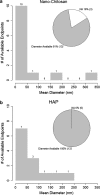Environmental hazard assessment for polymeric and inorganic nanobiomaterials used in drug delivery
- PMID: 30992030
- PMCID: PMC6466702
- DOI: 10.1186/s12951-019-0489-8
Environmental hazard assessment for polymeric and inorganic nanobiomaterials used in drug delivery
Abstract
Background: The increasing development and use of nanobiomaterials raises questions about their potential adverse effects on the environment after excretion and release. Published ecotoxicological data was searched for five polymeric nanobiomaterials [chitosan, polylactic acid (PLA), polyacrylonitrile (PAN), polyhydroxyalkanoates (PHA), and poly(lactic-glycolic acid) (PLGA)] and one inorganic nanobiomaterial [hydroxyapatite (HAP)] to evaluate the environmental hazards for freshwater and soil using a meta-analysis. If enough data was available, a probabilistic species sensitivity distribution (pSSD) and from this a predicted no effect concentration (PNEC) was calculated. If only one data point was available, a PNEC was calculated based on the most sensitive endpoint. Each material was classified either as "nano" or "non-nano", depending on the categorization in the original articles. When the original article specified that the material consisted of nanoparticles, the material was classified as nano; when nothing was mentioned, the material was classified as "non-nano".
Results: For PLA, PHA and PLGA, no published data on ecotoxicity was found and therefore no hazard assessment could be conducted. In soils, HAP was found to have the lowest PNEC with 0.3 mg/kg, followed by PAN and chitosan. In freshwater, chitosan was found to have the lowest PNEC with 5 µg/l, followed by nano-chitosan, HAP and PAN.
Conclusion: Compared with other common pollutants, even the most sensitive of the selected nanobiomaterials, chitosan, is less toxic than engineered nanomaterials such as nano-ZnO and nano-Ag, some common antibiotics, heavy metals or organic pollutants such as triclosan. Given the current knowledge, the nanobiomaterials covered in this work therefore pose only little or no environmental hazard.
Conflict of interest statement
The authors declare that they have no competing interests.
Figures






Similar articles
-
Probabilistic environmental risk assessment of five nanomaterials (nano-TiO2, nano-Ag, nano-ZnO, CNT, and fullerenes).Nanotoxicology. 2016;10(4):436-44. doi: 10.3109/17435390.2015.1073812. Epub 2015 Nov 10. Nanotoxicology. 2016. PMID: 26554717
-
Inorganic apatite nanomaterial: Modified surface phenomena and its role in developing collagen based polymeric bio-composite (Coll-PLGA/HAp) for biological applications.Colloids Surf B Biointerfaces. 2018 Dec 1;172:734-742. doi: 10.1016/j.colsurfb.2018.09.038. Epub 2018 Sep 18. Colloids Surf B Biointerfaces. 2018. PMID: 30248644
-
Comparison of species sensitivity distribution modeling approaches for environmental risk assessment of nanomaterials - A case study for silver and titanium dioxide representative materials.Aquat Toxicol. 2020 Aug;225:105543. doi: 10.1016/j.aquatox.2020.105543. Epub 2020 Jun 12. Aquat Toxicol. 2020. PMID: 32585540
-
Hazard Assessment of Polymeric Nanobiomaterials for Drug Delivery: What Can We Learn From Literature So Far.Front Bioeng Biotechnol. 2019 Oct 23;7:261. doi: 10.3389/fbioe.2019.00261. eCollection 2019. Front Bioeng Biotechnol. 2019. PMID: 31709243 Free PMC article. Review.
-
Biomaterials for Interfacing Cell Imaging and Drug Delivery: An Overview.Langmuir. 2019 Sep 24;35(38):12285-12305. doi: 10.1021/acs.langmuir.9b00419. Epub 2019 Jun 5. Langmuir. 2019. PMID: 31125238 Review.
Cited by
-
A Meta-analysis of Ecotoxicological Hazard Data for Nanoplastics in Marine and Freshwater Systems.Environ Toxicol Chem. 2020 Dec;39(12):2588-2598. doi: 10.1002/etc.4887. Epub 2020 Nov 10. Environ Toxicol Chem. 2020. PMID: 33002218 Free PMC article.
-
Nanofiber Carriers of Therapeutic Load: Current Trends.Int J Mol Sci. 2022 Aug 2;23(15):8581. doi: 10.3390/ijms23158581. Int J Mol Sci. 2022. PMID: 35955712 Free PMC article. Review.
-
A Methodological Safe-by-Design Approach for the Development of Nanomedicines.Front Bioeng Biotechnol. 2020 Apr 2;8:258. doi: 10.3389/fbioe.2020.00258. eCollection 2020. Front Bioeng Biotechnol. 2020. PMID: 32300587 Free PMC article.
-
Surface-engineered liposomes for dual-drug delivery targeting strategy against methicillin-resistant Staphylococcus aureus (MRSA).Asian J Pharm Sci. 2022 Jan;17(1):102-119. doi: 10.1016/j.ajps.2021.11.004. Epub 2021 Dec 24. Asian J Pharm Sci. 2022. PMID: 35261647 Free PMC article.
-
Sonosensitive capsules for brain thrombolysis increase ischemic damage in a stroke model.J Nanobiotechnology. 2022 Jan 21;20(1):46. doi: 10.1186/s12951-022-01252-9. J Nanobiotechnology. 2022. PMID: 35062954 Free PMC article.
References
-
- Li X, Lee SC, Zhang S, Akasaka T. Biocompatibility and toxicity of nanobiomaterials 2014. J Nanomater. 2015;2015:2012–2014.
-
- Bonakdar S, Mashinchian O. Stem cell nanoengineering. Hoboken: Wiley; 2015. Toxicology of nanobiomaterials; pp. 171–184.
Publication types
MeSH terms
Substances
Grants and funding
LinkOut - more resources
Full Text Sources

